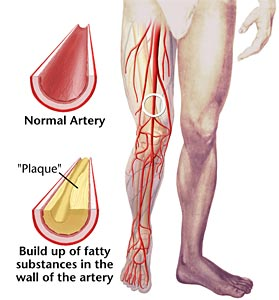[youtube nCJEuoSbW-A]
Peripheral artery disease (PAD) is a progressive circulatory condition in which the arteries that supply blood to the legs become blocked by plaque (fatty deposits), causing poor circulation and intermittent claudication (leg pain while walking). While only 50% of people with peripheral artery disease have blockages severe enough to experience pain, complications can lead to gangrene, limb amputation, heart attack and stroke.
Symptoms of Peripheral Artery Disease
Many people with peripheral artery disease have mild or no symptoms, but the first noticeable sign for most is intermittent claudication (IC). Characterized by muscle pain or cramping in the legs, IC is triggered by activities such as walking, but goes away after a few minutes of rest. However, not everyone experiences pain; some might feel a numbness, weakness or heaviness in the muscles. IC can range from mild discomfort to debilitating pain, and the location of the pain depends on the location of the blocked artery. As the disease progresses, IC may be experienced at shorter walking distances.
 Other symptoms of PAD include the following:
Other symptoms of PAD include the following:
- Numbness of the legs or feet at rest
- Cold legs or feet, especially compared to the other leg
- Hair loss on the lower extremities, especially the toes
- Changes in toenail growth
- Change of color of the legs or feet
- Paleness or blueness (cyanosis) of the legs or feet
- Weak or absent pulse in the extremity
- Ulcers or sores on the legs or feet that don’t heal
- Walking abnormalities
Depending on the severity of the blockage, a person may experience pain while at rest or lying down (ischemic rest pain). In some cases it may be intense enough to wake a person during sleep, but walking around can help to temporarily relieve the pain.
Causes of and Risk Factors for Peripheral Artery Disease
The most common cause of peripheral artery disease is atherosclerosis causing a reduction in blood flow to the legs. Other causes, though less common, include blood clots in the arteries, limb injury, unusual anatomy of the ligaments or muscles and infection. Age also plays a role in the development of the disease, especially in people 50 and older.
Other risk factors for PAD include:
- Smoking
- Diabetes
- Family history of PAD, heart disease or stroke
- High cholesterol or triglycerides
- High blood pressure
- High levels of homocysteine, a protein component that helps build and maintain tissue
- Obesity (a body mass index over 30)
- Excess levels of C-reactive protein, a general marker of inflammation
- Men have a greater risk of developing PAD than women
Smokers and people with diabetes have the greatest risk of complications. For smokers, quitting is the single most important step an individual can take to help stop the progression of peripheral artery disease and reduce the risk of a heart attack or stroke.
 Peripheral Artery Disease Treatment Options
Peripheral Artery Disease Treatment Options
The two main goals of treatment for peripheral artery disease are to manage symptoms, such as leg pain, and to stop the progression of atherosclerosis throughout the body. PAD can often be successfully treated by quitting smoking, exercising and eating a healthy diet. Doctors may also prescribe medicine to prevent blood clots, lower blood pressure and cholesterol, and control pain and other symptoms. For patients experiencing IC, angioplasty, bypass surgery or thrombolytic therapy may be necessary to treat the symptoms of peripheral artery disease.
In extreme cases, especially if the leg has gangrene, doctors may recommend amputating the lower leg or foot. However, more than 90% of patients with gangrene who are seen by vascular specialists can avoid amputation or have it limited to a small portion of the foot or toes.
Staying Healthy
Lifestyle changes that can help manage peripheral artery disease include:
- Managing diabetes by maintaining healthy blood sugar levels
- Lowering high cholesterol
- Lowering high blood pressure
- Quitting smoking
- Eating foods low in saturated fats and calories
- Maintaining your ideal body weight
- Exercising and walking regularly (at least 30 minutes 3 times a week)
If you suspect you may have or you’ve been diagnosed with, peripheral artery disease (PAD) learn what you can do to reverse peripheral artery disease by signing up for my free ecourse. Register for my free, no obligation eCourse: Reversing Atherosclerosis